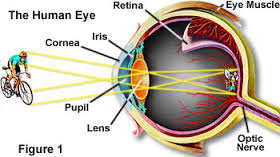
The retina converts light to electrical impulses. The cornea and lens bend light so it passes through the vitreous gel in the back chamber of the eye and is projected onto the retina. Light passes through the cornea and the pupil at the front of the eye and is focused by the lens onto the retina at the back of the eye.


These two fluids press against the inside of the eyeball and help the eyeball keep its shape. The large space behind the lens (the vitreous chamber) contains a thick, gel-like fluid called vitreous humour or vitreous gel. The chambers in front of the lens (both the anterior and posterior chambers) are filled with a clear, watery fluid called aqueous humour.
Blood vessels (retinal artery and vein) travel along with the optic nerve and enter and exit through the back of the eye.įluid fills most of the inside of the eye. The rest of the retina provides side (peripheral) vision, which allows you to see shapes but not fine details. The macula, near the centre of the retina at the back of the eyeball, provides the sharp, detailed, central vision for focusing on what is in front of you. Nerve impulses are carried through the optic nerve to the brain. Nerve fibres in the retina merge to form the optic nerve, which leads to the brain. The back two-thirds of the inner wall of the vitreous chamber is lined with a special layer of cells (the retina): millions of highly sensitive nerve cells that convert light into nerve impulses. Vitreous chamber: The vitreous chamber is between the lens and the back of the eye. Tightening (contraction) or relaxing these muscles causes the lens to change shape, allowing the eyes to focus on near or far objects (accommodation). Small muscles attached to the lens can change its shape, allowing the eye to focus on objects at varying distances. The lens is held in place by small tissue strands or fibres (zonules) extending from the inner wall of the eye. Light passes through the pupil to the lens. The lens is behind the iris and is normally clear. Posterior chamber: The posterior chamber is between the iris and lens. These muscles can control the amount of light entering the eye by making the pupil larger (dilated) or smaller (constricted). The iris uses muscles to change the size of the pupil. The iris controls the amount of light that enters the eye by opening and closing the pupil. Anterior chamber: The anterior chamber is the front part of the eye between the cornea and the iris. The inside of the eye is divided into three sections called chambers. The retina consists of two layers: the sensory retina, which contains nerve cells that process visual information and send it to the brain and the retinal pigment epithelium (RPE), which lies between the sensory retina and the wall of the eye. The inner layer is the retina, which lines the back two-thirds of the eyeball. In the centre of the iris is a circular hole or opening called the pupil. The front of the choroid is the coloured part of the eye called the iris. The slight bulge in the sclera at the front of the eye is a clear, thin, dome-shaped tissue called the cornea. The outer layer of the eyeball is a tough, white, opaque membrane called the sclera (the white of the eye). These layers lie flat against each other and form the eyeball. 
The eye is shaped like a round ball, with a slight bulge at the front.







 0 kommentar(er)
0 kommentar(er)
